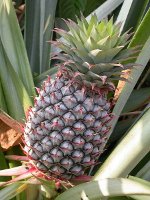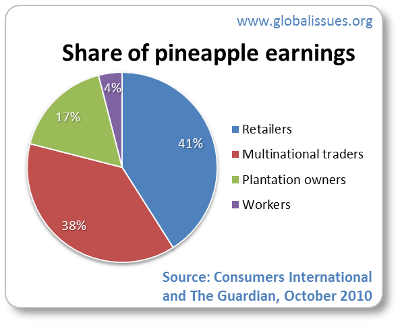Pineapples
Author and Page information
- This page: https://www.globalissues.org/article/789/pineapples.
- To print all information (e.g. expanded side notes, shows alternative links), use the print version:
 Pineapples are nutritious and popular. But the cheap fruit comes at a high cost. Health and environmental degradation has affected both workers and local communities. Price cuts in European supermarkets has led to wage cuts for workers already earning very little.
Pineapples are nutritious and popular. But the cheap fruit comes at a high cost. Health and environmental degradation has affected both workers and local communities. Price cuts in European supermarkets has led to wage cuts for workers already earning very little.
On this page:
Environmental and social damage from intensive production in Costa Rica

Europe gets some three quarters of its pineapples from Costa Rica.
Although this benefits Costa Rican producers and European supermarkets, an investigation by Consumers International (an umbrella group for independent consumer organizations across Europe) and The Guardian newspaper in the UK found environmental and social damage caused by intensive fruit production there.
More specifically,
- The constant use of agrochemicals has led to contamination of drinking-water supplies to communities around the plantations
- Repeated chemical accidents have inflicted serious damage on the local environment
- Workers reported suffering serious health problems from exposure to the chemicals used on pineapple plantations, including in some cases accidental chemical poisoning
- Price cuts in European supermarkets have led to wages being cut
- Efforts to join independent trade unions to improve conditions are said to have been met with repression and mass sackings
Felicity Lawrence, one of the researchers in the investigation interviewed Fernando Ramirez, a leading agronomist at the Costa Rican National University’s toxic substances institute, who explaining the agrochemical cycle required to produce perfect luxury fruit from a tropical monoculture:
Pineapples need very large amounts of pesticides, about 20kg of active ingredient per hectare per cycle. The soil is sterilized; biodiversity is eliminated. Fourteen to 16 different types of treatment are typically needed, and many have to be applied several times. They use chemicals that are dangerous for the environment and human health
… Some of the plantations have used paraquat, for example, to clear the soil at very, very high doses, 10 to 15 times the normal dose on other crops; it’s banned in Europe. They use lots of herbicides because the EU will not allow even one weed in a container of imports. This is absolute monoculture, … and the climate provide the perfect conditions for pests and diseases. They use organophosphates, organochlorines, hormone disruptors, chemicals that are known to cause cancer, chemicals that are reproductive toxins [cause birth defects]… Many are highly toxic, some are persistent pollutants.
The video that was produced follows some workers and local communities affected by the production of pineapples.
They found that workers are being squeezed struggling on very low pay — often less than livable wages, while toiling long hours and sometimes without sufficient time off.
The large scale, industrial, mono-production of pineapple means a lot of intensive chemical use as noted earlier. This, together with various accidents and chemical spillages has resulted in local water contamination, soil degradation and other environmental and health problems. Some local communities can no longer drink their water safely and must have water brought in from afar.
Cheap pineapples for consumers = lower wages for workers

This would seem good for consumers, but it seems the retailer is able to directly or indirectly squeeze the producers and it is ultimately the workers that are affected the most.
Felicity Lawrence, mentioned above, found that of every pound you spend on pineapple in the shop, retailers typically take 41p, multinational traders 38p and plantation owners 17p; where the multinational traders also own the plantations, they get 55p. Workers typically receive just 4p.
If that 4 pence per pound was enough to pay a livable wage, without exploitation and with reasonable working hours, then it would not seem so bad for the workers, perhaps (though the health and environmental damage would still remain as major issues).
Unfortunately, this is not an isolated problem with pineapples. Very often, media reports describe how the largest supermarkets squeeze producers, farmers and workers quite aggressively in their bid to reduce prices for consumers.
For consumers that are seemingly many miles away from the source of their foods, and are also facing financial squeezes of their own, given the debilitating global financial crisis, it can be easy to forget these issues.
More information
- True cost of cheap pineapples in UK supermarkets, The Guardian, October 1, 2010
- Bitter fruit: The truth about supermarket pineapple, The Guardian, October 2, 2010
- Pineapples case study, Consumers International, accessed October 3, 2010
Photo credit: pineapple by giniger.
Author and Page Information
- Created:
 Global Issues
Global Issues